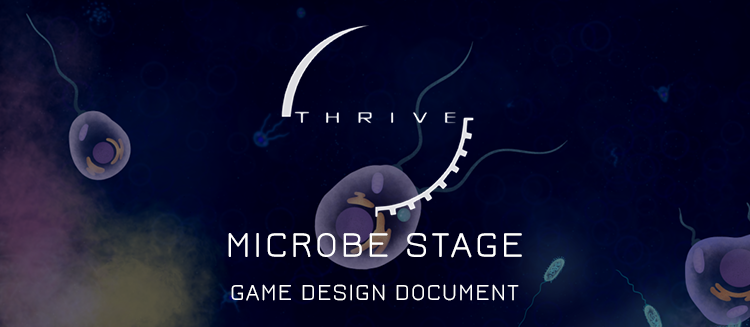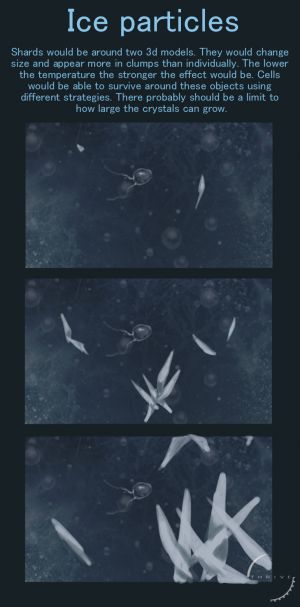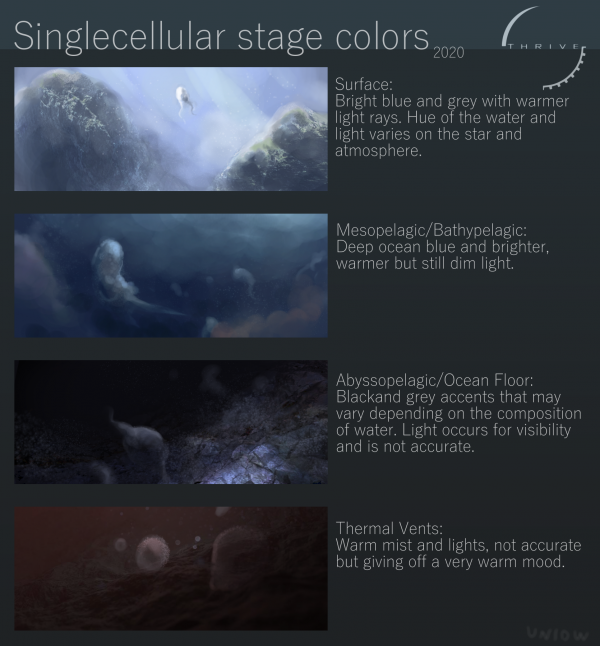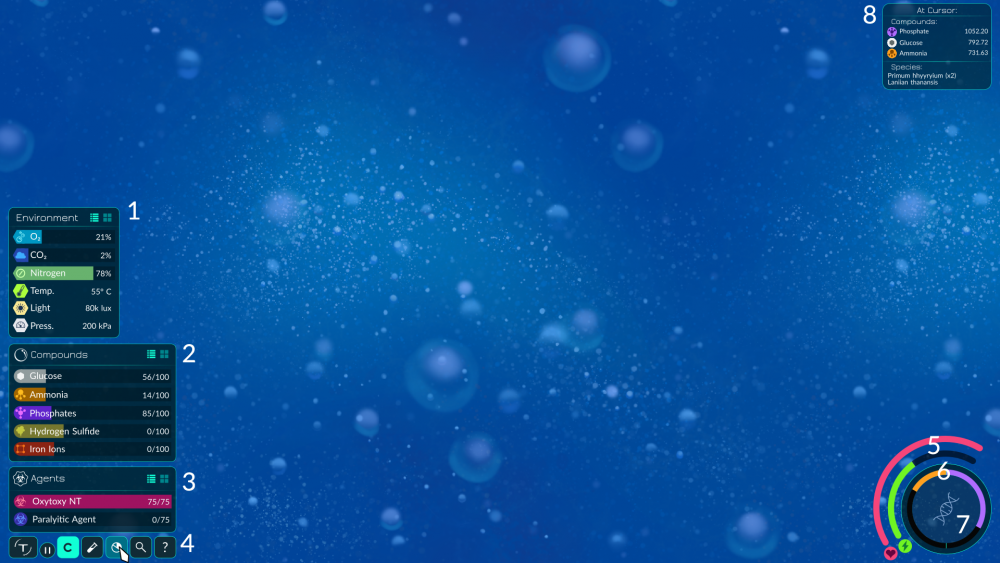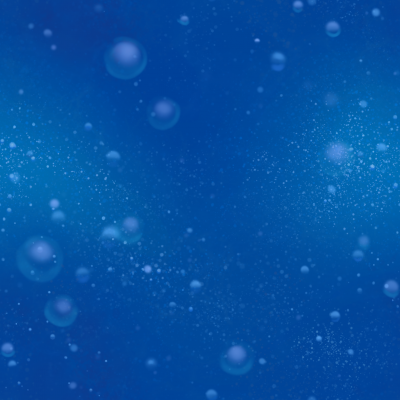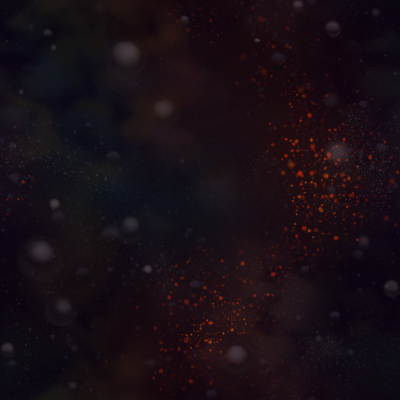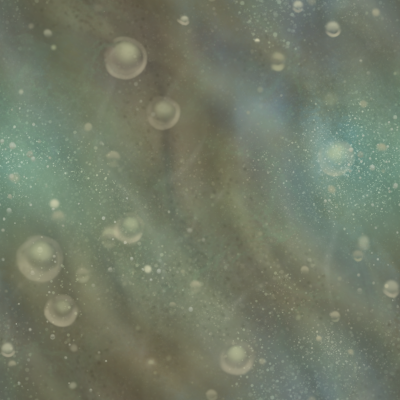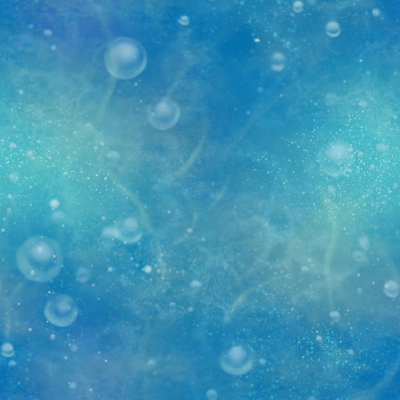Microbe Stage GDD
Previous stage: No earlier stages.
Next stage: Multicellular Stage
The Microbe Stage is the first stage of the game. You start off as a simple cell and must survive to collect enough nutrients to reproduce. Every time you reproduce, you can evolve your cell in the Microbe Editor. The stage ends when two cells of your species bind together. A cutscene will play before entering the stage, the camera will zoom on your planet and submerge into its ocean until it reaches a sea vent where it will zoom once more showing how the first cell form. After that the player will take control of this cell, starting the game.
Overview
The Microbe Stage can be seen as having two types of gameplay: Environmental gameplay, and editor gameplay. Environmental is when the player is controlling their cell, hunting for nutrients, and competing to survive; editor gameplay is when the player is in the editor, patch map and patch report designing their microbe to adapt to the competition and environment as well as letting their species migrate to other biomes.
Environmental gameplay is based on:
- Exploration
- Resource gathering
- Interaction with other microbes
Editor gameplay is based on:
- Seeing the conditions of neighbouring patches
- Learning about environmental changes
- Strategic evolutions to your microbe
- AI microbes that evolve simultaneously to you (Auto-Evo)
Transitions
Being the first stage, there is no transition into the Microbe Stage. To progress into the Multicellular Stage, the player will need to bind with another member of their species to form a multicellular colony. This is possible with the evolution of Adhesion Proteins.
Environment
Status: Work in progress
- The environment is the gameplay space of the microbe. The environment is comprised of abiotic (non-living) and biotic (living) components.
Abiotic Environment Components
- Water currents. A fluid dynamics simulation will have streams of liquid (usually water) current constantly flowing through the environment and represented by particle effects.
- Compound clouds. Procedurally generated clouds of compounds (coded by colour) will appear in the environment.
- Environmental conditions. Invisible noise maps of light, temperature, salinity, acidity, pressure, and other environment conditions will exist in the environment.
- Surfaces. Procedurally generated solid barriers that block movement and currents, representing rock formations underwater.
- Rocks. These elements can be a resource source for microbes, like iron chunks or a source of energy like radioactive rocks. They can emit compounds and cells can colide with them.
- Ice shards. Only available in cold biomes, these ice crystals damage cells when coliding with them and wil clump in bigger chunks as the temperature decreases.
Biotic Environment Components
- Microbes. The environment will start with one initial species consisting on a single hex of cytoplasm, and then Auto-Evo will evolve this into many species over time.
- Cell chunks. Or Marine Snow, on certain patches this will be the main energy resource, it consists on floating organelles and cell chunks coming from the patches above. They strand around the enviroment being moved by the ocean currents.
- Organic Molecules. Large free floating molecules will be present in the environment. This includes strands/clumps of DNA, proteins, bubbles of membrane/fats, and chains of sugars. They require special adaptations to digest. If the player absorbs them and digests them, they will grant an increased amount of compounds than a cloud. Absorbing the DNA also has a chance to unlock a new organelle for use in the editor.
Environment Layers
- Foreground. Will contain faint visual effects for aesthetics.
- Midground. The layer that contains the player and the other environment components.
- Background. The parallax set of layers behind the player that is for aesthetic purposes. Contains the background images, particle effects, etc. The background color will change depending on the patch properties, like light level and temperature.
It has been sugested to add living cells on both background and foreground, and even letting the player move to those layers.
Biomes
Main Article: Microbe Biomes
- The environment is split between multiple Biomes or Patches. The biome you're in determines the appearance of the environment and the presence and abundance of the different biotic and abiotic components.
- Other biomes cannot be reached via in-game travel. Instead the player will have to choose which biome to spawn in the patchmap.
- There are certain restrictions on what biomes can be found adjacent to other biomes.
Compounds
- Compounds can be thought of being like resource gathering from other games.
- The player's microbe and other microbes need certain compounds to survive. Compounds that a microbe needs to survive are often called nutrients. A compound might be a nutrient for one species but not for another.
- Compounds are automatically absorbed by microbes by swimming through them, if the microbe has space to store it. They are stored in the cytoplasm or in vacuoles.
- Clouds move with the currents, gradually diluting.
- Compounds can be found throughout the environment in several different forms:
- Free floating (compound clouds). These are coloured by the type of compound they are.
- Concentrated in certain areas (heat/light spots).
- Contained within other microbes (storage or as part of their organelles).
- Agents also appear in the environment in the form of coloured clouds (coloured by type). Agent colours are more nuanced and difficult to decipher. More details here: Agents. Since adding new clouds could make the game confusing it has been sugested to represent agents with particle clouds instead.
- Compounds enter the environment from several sources:
- Microbes. May eject some as waste or drop them upon death.
- Natural sources. Volcanic vents, limestone, etc.
- The player can gather compounds from any of these sources.
- Energy comes in the form of ATP, which cells create from their compounds. ATP is for the most part treated as a compound.
- Cells release unnecessary compounds as waste.
- Absorption and ejection of compounds happens passively. There is a limit to the rate that compounds can be absorbed/ejected in a given moment, and that is based off of the surface area of the cell.
Movement
Status: Work in progress
- Because of the size of the organisms in this stage, they will be heavily affected by fluid dynamics.
- Pseudopodia (Ameboid movement) will be less effective in stronger currents, in which case movement organelles would be necessary.
- The player will have to navigate the currents and can use them to their advantage.
- The speed of the cell and the turning ability will depend on the organelles.
- Heavier cells will be harder to move. Weight is determined by size, organelles, stored compounds, etc.
- The cell will face the direction that your cursor is in.
Mutations
Status: Work in progress
- Microbes have a set of possible changes they can make each time they enter the editor. These are referred to as mutations. Some mutations are the placement or modification of internal cell parts, called organelles.
- Organelles are internal machinery, like organs, which allow a cell to perform certain abilities. The player starts with only DNA and a membrane, neither of which technically count as organelles. They can acquire organelles as the game goes on. Organelles are required for a cell to function properly and are crucial for survival.
- Organelles can be upgraded. Organelle upgrading will not be as good as organelle obtaining, pushing upgrading back to mid-game.
- New organelles can be unlocked through two ways:
- Endocytosis - Player unlocks an organelle by engulfing another microbe.
- There has to be enough free cytoplasm in the cell for an organelle to be assimilated.
- An assimilated organelle is unlocked and also has a copy placed in the cell.
- Organelle Cross-grades/Upgrades - Player upgrades an organelle into a different one (E.g. Cilia to Flagellum).
- Lamellipodia, pilus, cell wall, agent vacuole
- Endocytosis - Player unlocks an organelle by engulfing another microbe.
- Organelles will slowly drift around their placement point in a cell for visual appeal
- The membrane will distort based on the microbe's interactions with the environment (e.g. Engulfment and movement)
- A player can turn an organelle's function off from the organelle priorities panel. A turned off organelle will either be darkened or dimmed in colour.
Combat
Combat's main purpose is to kill another microbe to obtain the compounds it holds. Three main forms of combat:
- Agents - Can damage or inhibit organelle/behaviour. Can damage attacker as well.
- Predatory Pili - Pili rupture a cell's membrane, but can also act as agent secretors. Pressing a hotkey will make the pilus extend/activate. Cell walls are more resistant to pili.
- Engulfing - The traditional form of combat available to most cells. A microbe can usually engulf a microbe smaller than itself, provided he has an engulfing edge. Once ingested, a foreign microbe is digested inside overtime.
There are also defenses against these dangers;
- Cell walls - These structures can be of different types (cellulose, chitin, silica...) deppending on its type the wall will have a given resistence againts either (or both) agents or pili. They can also increase the cell's health and decrease its movement speed.
Health and Death
Health is measured with HP, this will decrease when the cell runs out of ATP or when it's damaged. Whenever a cell looses HP it will flash in red. As the cell is damaged cracks will appear on it's surface. After some time without receiving damage it will slowly regenerate. If a microbe bursts, it is considered dead, there are multiple ways this can happen. If the cell runs out of ATP and can't produce more it cannot control osmosis and the cell dies by osmolysis (water explosion). Cells will initially swell to indicate this as a warning.
Osmoregulation
The cell membrane is assumed to be constantly undergoing osmoregulation passively (using pumps to balance water inside and outside of the cell). Osmoregulation is necessary for the cell to not fill with water, burst, and die. This means that the cell is constantly using a baseline of ATP to keep itself alive. This is why blank cytoplasm hexes still increase ATP consumption. When a cell runs out of ATP, osmoregulation will fail and the membrane will burst. This type of death is known as osmolysis. Highly upgraded cell walls can prevent osmolysis.
Engulfment
- A cell can die from being engulfed by a larger cell.
- A cell can use pili or agents from inside a cell to escape.
Death
Upon death, a microbe will release its stored compounds and some of its organelles intact into the environment. Organelles require engulfment to be absorbed, unless an agent breaks them down first. External organelles and periphery organelles collapse immediately along with the membrane. Neither release any compounds into the environment. The nucleus has a small chance of dropping on death. Consuming a nucleus grants compounds and an additional 25 mutation points in the next editor session (doesn't stack).
If the player cell dies, the camera freezes in place for a few moments to show how they died, then fades to black. It then fades back in focused on a new cell of the player’s species in the same biome. This cell has low compound stores. If no members of the player’s species are available in the biome, the player is randomly assigned a new individual from another biome. If there are no other members of their species at all, they’ve gone extinct and lose the game. The player sees a brief game over screen (with no sound, explaining that their species has gone extinct), before being sent back to the title screen.
NPCs
Status: Work in progress
An NPC is any in-game entity which can think for itself. There are two main NPC types: eukaryotes and prokaryotes. AI species evolve via Auto-Evo. This evolution takes place while the player is in the editor.
- Different modes of AI (predatory, plantlike, prey-like possibly).
- Surviving, seeking out necessary compounds and feeding on them.
- Killing other microbes (predator mode), this involves using agent vacuoles and pili effectively.
- Fleeing from predators (prey-like mode, and possibly predators from larger predators)
Prokaryotes
The player starts as a prokaryote or bacteria. They have access to a limited number of organelles and can't use membrane enclosed ones. Their organelles consist on membrane proteins and peripheral organells, like flagella.
Eukaryotes
Scientifically, a eukaryote is any cell which contains a nucleus. They have access to more efficient organelles as well as prokaryote proteins.
Interaction
- Microbes will compete with one another for resources.
- They can attack and kill one another or flee.
- They can also form co-operative colonies and assist each other.
Reproduction
Status: Implemented
- Only possible reproduction is asexual. Conjugation may be possible on new releases and it would grant cells a MP bonus.
- Reproduction for microbes is a gradual and incremental process.
- While a microbe is undamaged, it will slowly use its stored compounds to grow its organelles. It will grow only one organelle at a time.
- Once an organelle grows to double its normal size, it splits in half. The cell repeats this process until every organelle has split except the nucleus.
- When all organelles have doubled, the reproduction button pops onto the screen. Clicking the button will show an animation of the enlarged nucleus splitting, and then take the player to the Microbe Editor.
- After exiting the editor, the cell splits in two with each daughter getting one copy of the organelles. All other microbes of the player species in that biome will be changed to match the mutations.
Microbe Editor
Status: Work in progress
- Only available editor in this stage is the Microbe Editor.
- It is entered as mentioned above.
- Each editor session grants a limited number of Mutation Points (based on difficulty). 100 MP by default. Each possible change costs a certain number of MP.
- The player can add/edit/remove organelles to their cell or change it's shape, size, or structure.
- For more detail see Microbe Editor.
Symbiosis
- Technically, symbiosis refers to relationships between species that are either positive or negative, but for Thrive by symbiosis we mainly reference beneficial symbiosis.
- Symbiosis can develop naturally or artificially through binding agents.
- At first, colonies will be rare or nonexistent. Eventually, they will start to form using signal and binding agents. Colonies allow constituent cells to specialize. The game environment should be weighted towards incentivizing colonies near the end of the stage.
Colonies
- Only single-species colonies can form.
- It’s possible it may use a bitmask system similar to agent resistance.
- Cells can release a binding agent which will make them attach. They will stay attached unless one cell makes a strong motion to swim away from the other. Colonies will also need signal agents to prevent constituent cells from breaking off.
Emergent Symbiosis
- Cells may be able to work together to benefit each other.
Disasters
- Disasters can affect one or more biomes.
Mass Extinctions
- Rare even in high difficulty.
- Mass extinctions never happen concurrently with each other or natural disasters.
Other Disasters
- Asteroid Impact – All biomes become much darker (atmospheric dust), reducing light spots. One non-player biome is randomly chosen to have most of its inhabitants killed off.
- Snowball Earth – All biomes become much colder, reducing heat spots. Water currents also slow in many places. Ice appears as white floating shapes.
Natural Disasters
- Natural disasters are much less violent than extinction events, but are more frequent. They affect small numbers of biomes, often as little as one. Their effects plug into the CPA simulation just as extinctions would, but generally don’t have as big an effect.
Natural disasters never happen concurrently with each other or mass extinctions.
- Volcanic Eruption – Similar to an asteroid impact, but less widespread with less drastic effects. A few adjacent biomes become slightly darker and hotter.
- Earthquake – The player’s view shakes for ten seconds and water currents change direction in one biome.
- Virus – One species in a biome is chosen at random to be attacked by a virus. A virus may affect the function of one or more organelles, reducing their efficiency, sometimes heavily. If the player encounters or becomes an infected individual, the affected organelle will glow red and the entire microbe will have a slight red glow.
User Interface
Main Article: Microbe Stage GUI
The interface and controls of the stage.
- UI is based on a minimalist design
- In the bottom right, it shows the players compound stores.
- In the bottom left, there are six buttons.
- One has a question mark, and is the Help button.
- Next to that on the right is the Save button.
- Below that there is the Load button.
- Clicking the button right in the very corner will hide this part of the interface.
- In the top left, there is a display of the player's health.
- In the top right, there is the button for the main menu.
Status: Implemented
Game Screens
Main Article: Game Screens
What is displayed to the player in each section of the game and how to travel between them.
Progression
Main Article: Microbe Progression
The different abilities and mechanics available at different stages of the game, and how to win.
Simulation Specifics.
Main Article: Game Features
The nitty-gritty of the game world and its simulated aspects. The different systems for simulating the microbe stage can be found in the main page linked above.
Visuals
The game’s overall visual style vaguely resembles a microscope image of cellular structures, but with slightly more vibrancy and colour. Generally, realism should be favoured unless such a design would be highly unintuitive (for example, real world cells are mostly transparent, but having the player use a fully transparent microbe in an environment filled with fully transparent microbes would make gameplay difficult). There should also be influences from less realistic science fiction aesthetics, especially in the design of the GUI.
Depending on the biome, the environment will have a given luminosity and colors, these are supposed to change on their own according to the planet's current state. For instance, if the atmosphere is covered in volcanic ash all biomes will have lower light levels and this would be reflected on the game environment as well, making everything look darker. Here are some general guidelines for how patches should look like:
General
Rules of thumb for asset design:
- Psuedo-randomness. Textures with organic order, e.g. Perlin Noise, Voronoi Textures and real-world organism texturing.
- Uniform sharpness. Texture should contain sharp/bold, medium sharpness or soft edges only. Try sharp edges first and blur to desired degree. Individual objects always have uniform focus, objects blurred depending on distance from camera like microscopic image.
- Light, desaturated colors. Matches real microbe pigmentation, i.e. mostly transparent.
- Realistic color types. Avoid purples, pinks or yellows (not found in nature). Focus on blues, greens, reds and pale oranges like this color palette (accented in white). Exceptions can be made where distinction is needed, e.g. a purple nucleus.
A palette is needed here
GUI
This is a concept for the current UI. Its elements are:
- Environment panel. It shows the enviromental conditions of the patch or the place the player is in.
- Compound panel. Shows how much of each compound the player cell has.
- Agent panel. Shows how much of each agent the player cell has. All these panels can be compressed with the buttons on their upper right corner.
- Toolbar. Different tools available for the player, these are from left to right:
- Main menu
- Pause button
- Hide funcion. It hides the panels above
- Processes button
- Stats button
- Search function. It will pause the game and let the player examine other species by clicking on them
- Help
- ATP and HP bars
- Reproduction progress bar. It shows how much amonia and phosphates the cell needs to reproduce. It becomes white when it's complete.
- Editor button. It glows once the reproduction bar is full and let's the player access the editor and patch map screens.
- Navigator panel. It shows which compounds and species are under the cursor.
- GUI should be minimal to immerse the player.
- Many elements should have toggle options to be shown on-screen or not, such as the compounds panel.
- Each button/panel should convey only a few pieces of information. Each button should be a separate image. Icons in line with Thrive's iconography style should be used wherever possible.
- Icons and text should be white with the exception of compound or other icons which are identifiable by virtue of their unique color and symbol.
- GUI animations should be quick and simple.
- When the pause menu or other overlay is active, a transparent grey rectangle appears over the game screen with active GUI elements above it.
Guide for making GUI elements:
- Build a rectangle. Ends should be rounded, with both vertical and horizontal radiuses of 8.770 px.
- Color the shape #002124 with an alpha value of 192.
- Give the shape a stroke with 0.600 px width and color it #11ffd5.
- Hover variants are the same except the fill is #006f86 .
- Active variants are the same except the fill is #11ffd5, the same as the stroke. Plus their normally white icons are #112b36 now.
- The Jura font is used on heathers and panel names, while Lato is used on the text inside the panels.*
- Heathers are separated by divider strokes, these are lines with a radial gradient. The color is #112b36, it's opaque at the center and completely transparent at the extremes. The stroke width is 0.750 px.
Models
There are two types of 3D models used in the game: static and procedurally generated.
Static
Static models have pre-defined shape throughout all situations, so can be created by modelers beforehand.
There are various static model needs:
- Organelles. All internal organelles will retain their shape while floating around inside microbes. For the nucleus, mitochondria, chloroplasts, etc. only a single model is needed for each. External organelles do change form, but in exact animations, discussed in the next section. Periphery organelles consist of a shader applied to the whole microbe, covering it in cilia for example.
Once organelle upgrading is implemented, models should be dynamic and change their shape to reflect these changes.
- Rocks. There is a set of premade rock models which would change their texture depending on the type of rock they are. Eventually these models should be generated procedurally.
Procedural
Procedural models are created and updated by the game on the fly based on environmental or player input. There are several rules for creating each, and pre-made visual elements can be used (such as patterning on a membrane), but the exact mechanics describing how each may be generated are explained in the simulation specifics section.
Like static models, procedural models come in many types:
- Membranes. Membranes are perhaps the most complex example of procedural generation within the game, relying on multiple factors. Initially, a microbe’s membrane is drawn based on its cytoskeletal hex structure, before becoming flexible and taking a more natural appearance. Cytoplasm area should be near enough the same between the hex arrangement and procedural shape, and should retain some aspects of what the player or Auto-Evo has decided a microbe is shaped like. Protruding lines of hexagons, for instance, need to remain about the same length and position. A further complication in drawing a membrane is that a microbe’s shape is defined in 2D, but the model needs to be rendered in 3D. Thickness should vary intuitively, i.e. thicker towards the center of a microbe and thinner at the edges, before curving over at the edges to an unseen underside. Membranes are overlaid with patterning and coloration, which also can’t distort too drastically. Environmental distortion also affects membranes. If a microbe pushes into another, its leading edge should squash. Similarly, the edges of a membrane may be affected by water currents, making streamlined organisms more effective. Of course membrane rigidity will change their appeareance, making them look less fluid and deform less.
- Surfaces. A surface is any inorganic object in the environment, such as rock or ice (the latter appearing during snowball Earth disaster events). All surfaces have the same uniform thickness, but their outer edges are generated procedurally. There are very few constraints on their form, but they shouldn’t exceed a certain size.
Animations
Most of the animations required for the microbe stage are for organelles. Though technically static models, they do exhibit dynamic behavior, but unlike the procedurally generated models, this behavior is pre-planned. The only difficulties arise when changing between different animations.
Movement organelles oscillate to drive cells forward through the environment. Flagella should either twist (like twirling springs) or wiggle (like a moving sine curve), animator’s choice. Cilia are similar, but much smaller, so will only change direction a couple of times along their length within one oscillation (unlike flagella, which do this multiple times). Lamellipodia should look and animate like a crowd of stumpy legs, changing their direction of oscillation depending on which way the microbe is travelling. The rate of oscillation for every organelle should scale with speed, becoming zero when not in use.
Other external and periphery organelles need simple animations. Pili should extend and retract organically but quickly, while agent secretors should compress slightly when secreting agents. All membrane animations are discussed in the previous section.
Internal organelles aren’t animated, other than their random floating around inside membranes. They may exhibit gradual changes of color depending on their rate of function or health level.
Backgrounds
For the microbe stage, the background will generally be the ocean itself. Depending on the biome and patch conditions (like temparature and light level), its visuals will change. Thus backgrouns will be procedurally generated. But since that's not possible at the moment different background textures are required.
All backgrounds must feature a tiling pattern with no discernible gaps between panels. The patterning itself needs to be complex but inconspicuous, and doesn’t necessarily need to look completely natural. Bubbles and particles can appear above the background, and will move to give the illusion of parallax. Everything should be at a microscopic scale, with the foreground appearing to be only slightly raised from the background.
As the player swims, the background should remain stationary (moving relative to the field of view), so it appears that the player is moving across the sea. A background must be sized so that its tiling isn’t clear, even when a player has zoomed out to the maximum extent.
Here are some background examples:
Midground
Between the foreground and background is the midground, which shows the paths of water currents and compound clouds. Water currents are distinguished by variances in water shading and lighting as well as particle effects, to give the impression of ripple or waves. The water is mostly transparent other than these tints.
The midground may also have a few organisms in it (as microbes don’t necessarily travel over a single plane), but the player and other foreground microbes will be unable to interact with them. All midground objects must be obscured by the water currents and heavily blurred to show this distinction.
Compound Clouds
Whenever a compound or agent spills into the environment, it produces a compound cloud. These are tied into the grid representation of compounds, where each point has an associated level of each compound. Higher concentrations have a more vibrant compound cloud of their associated color (e.g. glucose’s color is light gray, so compound clouds of oxygen are white). The only exception is water, which is transparent and doesn’t change visually whatever its density.
Compound clouds can mix, and billow following the path of water currents. Gradually they'll become less dense as they spread out, eventually becoming invisible after a certain point. When a microbe enters a compound cloud, it may collect the compound if it has enough storage or processing space. This reduces the concentration of that compound in the area the microbe has traveled over, lightening it slightly.
Due to some compounds being more common than others, the scale for how vibrant a compound cloud is should not be the same for all. It should require a higher concentration to achieve the same color intensity.
Agents are special case compounds. The color of each agent varies, but as of yet the exact coloration hasn’t been determined. To distinguish them from regular compound clouds, they would use particle clouds. There should be some visual cues involved – lure and signal type agents should appear positive (greens) while damaging agents should be negative (reds).
Audio
Main Article: Microbe Audio
What the game sounds like.
Miscellaneous
Main Article: Microbe Miscellaneous
Things not covered elsewhere.
Related threads
- GDD: http://thrivegame.canadaboard.net/t1257-microbe-stage-gdd?highlight=Microbe+stage
- UI: https://forum.revolutionarygamesstudio.com/t/microbe-gui/111
- Patch map: https://forum.revolutionarygamesstudio.com/t/patch-map-design-discussion/597
- http://thrivegame.canadaboard.net/t1049-microbe-stage-development?highlight=Microbe+stage
- http://thrivegame.canadaboard.net/t866-microbe-stage-progress-report?highlight=Microbe+stage
- http://thrivegame.canadaboard.net/t1428-microbe-release-planning?highlight=Microbe+stage
Appendices
There are some tables and other things collected in the Microbe Stage Appendices
